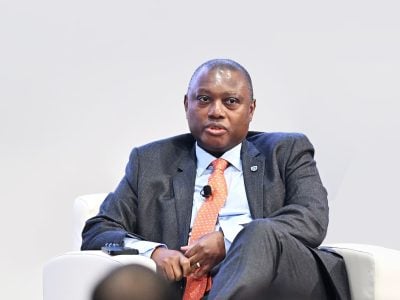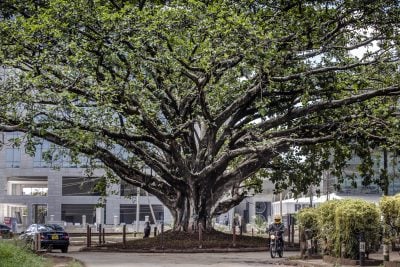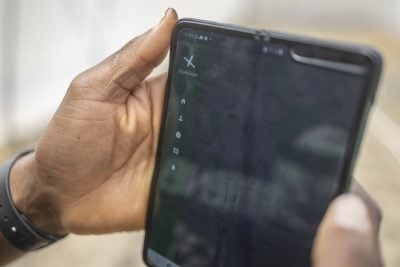African banks are taking a lead in drawing together the continent’s economies, and increasingly operate across borders. The biggest banks continue to be the winners, both at working across different jurisdictions and at adopting new technology and adapting to it, and their healthy finances and global networks ensure they are likely to feature in Africa’s Top 100 Banks 2024 (For this year’s full ranking, please scroll down).
The rise of North African banks has been the main change. South Africa’s banking giant Standard Bank Group has been Africa’s standalone Top Bank every year, while the National Bank of Egypt has been second for the last four years. The gap between them has been closing a little, but Standard Bank, with Tier 1 capital of $12.5bn, is still more than two-thirds bigger than its rival, whose Tier 1 capital is $7.5bn.
Morocco’s Attijariwafa Bank has climbed three places to third after its Tier 1 capital – the main measure of the annual ranking (see “Methodology” below) – climbed by a strong 12% to $6bn. South Africa’s Absa Bank, which fell back in the rankings last year, is back up to claim its number 4 spot, despite a 1% retreat in its Tier 1 capital, a sign of how core operating capital has retreated at some of Africa’s other banking giants compared to the 2023 ranking.
Banque Centrale Populaire, another Moroccan bank, has climbed to fifth place. Egypt’s Banque Misr fell back 30% on Tier 1 capital and ranks sixth (down from third). South Africa’s Firstrand, Africa’s biggest bank by market capitalisation (the total value of its shares listed on the Johannesburg Stock Exchange), has seen a 13% decline in its Tier 1 capital and is down to seventh (from fifth), while fellow South African group Nedbank has seen capital down 23% and is eighth, down from fourth in the list.
There was little change in the next three on the ranking: Banque Exterieure d’Algerie stays at ninth despite a 3% slide in Tier 1 capital; Morocco’s Bank of Africa – BMCE Group is up one place to tenth and displaces Banque Nationale d’Algerie to 11th.
Standard Bank also dominates when it comes to net profit or loss, with a strong rise to $2.7bn profit, up 18% on the year before. The bank has more than recovered from a dramatic fall in net profits in the year to December 2021. Its African operations in 19 countries (see below) are performing better than the group as a whole, as measured by compound annual growth rate in revenue, cost-to-income ratio, and return on equity (ROE).
FirstRand’s net profits are down to $1.4bn, down 13% on the year before, and in the year to June 2023, 11% of earnings came from “Broader Africa”. Banque Misr has profit of $1bn, down 30% on 2023.
Nigeria’s top bank by Tier 1 ranking is FBN Holdings (First Bank of Nigeria), ranked at 15 (down one place), with capital of $1.9bn, closely followed by Access Bank (16th) and Zenith Bank (17th, down from last year’s ranking as Nigeria’s top bank at 12th).
Dramatic declines in Nigeria’s naira currency compared to the US dollar (USD) affect the rankings in this year’s table, since banks report their figures in domestic currencies and the research team compiling the rankings convert into USD either at the date of the results or another date (see “Methodology”). For instance, Standard Bank increased its Tier 1 capital in local currency (rand) compared to the year before, but it falls back when translated into USD due a slow slide in the value of the rand over the year.
Profits and ROE: Some startling returns
Nigerian banks rank highly when it comes to Return on Equity (ROE), a key measure for investors. The top-ranked bank by this measure is Rawbank of the Democratic Republic of the Congo (DRC), a returning entrant at 88th in the table with net profit of $179m on Tier 1 capital of $286m, for a dramatic 62% ROE. HSBC Bank Egypt is close behind, with ROE of 61% for net profit of $397m on Tier 1 capital of $649m.
The total ROE across Africa’s 100 Top Banks has more than recovered from the lingering effects of the Covid-19 pandemic and other problems. It is 20% for the current ranking, up from 17% in 2023 and 14% in 2022. The ROE was down to 12% in 2021, after falling from 19% in the 2020 ranking.
By comparison, the average ROE for US banks for the first quarter of 2024 was reported to be 10.3% and any ROE greater than 10% is considered good by many analysts. The ROE for 2023 for global banks has not been reported but is expected to be 13%.
Nigeria’s giant Guaranty Trust achieved a very strong 57% ROE on Tier 1 capital of $1.1bn. Four Egyptian banks are among the continent’s best yielding for investors: Housing and Development Bank (ROE 57%), Credit Agricole Egypt (55%), Commercial International Bank (CIB) (49%), and Abu Dhabi Islamic Bank – Egypt (48%).
Nigerian bank United Bank of Africa (UBA) achieved ROE of 42%, slightly ahead of compatriots Zenith Bank (41%), Stanbic IBTC in Nigeria (38%), and Access Bank (38%).
Usually, higher interest rates in the domestic market boost the profits that banks earn from net interest margins, the difference between the cost banks pay when they borrow (from depositors and the market) and the income they receive from loans (interest).
Only two banks in this year’s ranking were loss-making: Absa Bank (Ghana) with its December 2022 results; and Angola’s Banco de Poupanca e Credito (see Southern Africa below). This is down from three loss-making banks in the 2023 ranking.
The continent’s economies are still recovering from shocks
African economies continue to feel the shocks of the last few years, including volatile global food and energy prices after Russia’s invasion of Ukraine shook global markets and interrupted some food supplies.
Adverse effects from climate change also affect economies. Inflation in many countries has been high, affecting the poorest the hardest, and many African central banks have pushed up interest rates, boosting profits at banks, as highlighted above.
The African Development Bank (AfDB) says that economic growth (measured by gross domestic product, GDP) fell to 3.1% in 2023, down from 4.1% in 2022. Growth is set to climb to 3.7% in 2024 and 4.3% in 2025. Africa is the second fastest growing region in the world after Asia-Pacific.
According to the International Monetary Fund (IMF) World Economic Outlook released in April 2024, 9 of the top 20 economic growth rates in 2024 are in African economies: Niger (the 3rd fastest growing in the world), Senegal, Libya, Rwanda, Côte d’Ivoire, Djibouti, Ethiopia, the Gambia and Benin, some off low bases.
Fast growth in Niger and Senegal are expected to be driven by oil and gas, among others. In East African countries such as Rwanda, growth is driven by services.
Star performers in terms of growth in the coming years could include Mozambique (compound annual growth in GDP is projected to be 7.9% a year from 2024 to 2029), Rwanda, Ethiopia, Niger, Uganda and Senegal.
Population across many countries continues to increase, reducing the gains when growth is considered per capita.
Realising the full gains of increasing population (the so-called “demographic dividend”) will depend on continuing changes towards more productive and efficient economies, with fewer structural difficulties.
Digitalisation and the promise of ‘leapfrogging’ older technologies
Africa is a world leader in mobile money, the money transfer services initially offered by telecommunication firms.
A leading example is the M-Pesa service provided by Kenya’s Safaricom. In some countries 90% of transactions are in cash, with many businesspeople adept at counting huge wads of bank notes even for food purchases.
By comparison, Africa lags the world in digital banking. Only 20% to 30% of Africans are estimated to use digital banking services, compared to some 50% in Latin America and Asia and over 70% in most developed economies.
The continent’s banks aim to leapfrog several stages of banking development, including cheques, debit cards and credit cards. Each involves building and rolling out costly infrastructure. In many African countries, credit and debit cards are hardly used yet; so banks aim to move their customers from cash and mobile money directly to digital.
Rapidly growing internet access
This is aided by the rapid growth of internet access, data centres and smartphones, with Chinese versions that cost less than $100 each starting to be widespread. Even the most basic phones can handle most mobile money transactions, but more sophisticated mobile banking usually requires more capacity.
Key digital banking services include signing up and screening customers (digital identity checks can now be very fast), savings and payment services. Banks are rapidly rolling out digital lending including automated assessments of credit applications and customers’ ability to repay loans, and offering self-service customer support. However, digital platforms for investments remain a long-term dream in many countries where incomes are still low.
Banks are already spending heavily on investing in digital transformation. They hope to recoup the investments through winning more customers and improving efficiencies in back-office administration and in complying with regulations. They aim to save costs on branches and staff, and there is evidence already that the number of branches per person is starting to dip.
Telecommunications companies are spurring competition. Kenya’s M-Pesa has long been taking business from banks, at the same time bringing them new business.
Neobanks are yet to turn much profit
Banks which have recently launched and offer only or mainly digital banking are referred to as “neobanks”. In Africa they are concentrated in South Africa (Bettr Bank, Tyme Bank and Discovery Bank) and Nigeria (Opay and Vbank); a few are springing up in other countries such as Egypt, where there are advanced tech skills and the regulator is also open to new ideas. Both conditions are particularly true in Kenya, where competition is very fierce for newcomers.
Most of the leading African banks in the ranking have focused on adapting to digitalisation in order to head off the competition and make the most of new technology. During the Covid-19 pandemic many services had to move online and banks have maintained the momentum.
Worldwide, few digital-only banks have yet seen any profit, despite their fast growth, and Africa’s neobanks follow the same trend. South Africa’s Tyme Bank announced its first profit for the year to December 2023.
By comparison with the newcomers, established banks hold large sums in customer deposits, which provide cheap financing during times of high interest. This has financed the banks’ efforts to roll out retail banking solutions and digitalisation, and to develop new products for business and other needs. To do so they must either build in-house expertise, or form partnerships with specialised fintech companies, or adopt a hybrid model, depending on what they are learning.
The Top Banks survey includes banks with many decades of experience in Africa. How many will be around in another two or three decades will depend partly on how fast they seize new opportunities.
The African Continental Free Trade Agreement: bringing Africa together
Banks are moving fast to draw the continent together economically, taking advantage of continental initiatives such as the African Continental Free Trade Agreement (AfCFTA).
Well-run and profitable subsidiaries do well in the Top Banks rankings. For example, top-ranked Standard Bank Group, which has been acquiring banks across Africa and growing since 1988, controls Standard Bank (Mozambique), ranked 57th with Tier 1 capital of $445m and Stanbic IBTC in Nigeria (ranked 63rd), Stanbic Bank Uganda (71st) and Stanbic Bank Kenya (86th).
The group has a presence in 19 countries in sub-Saharan Africa and is among the top three banks in ten of these markets. Some 42% of its earnings come from “Africa regions”, according to the 2023 financial results, and growing profits from these countries help insulate the banking group from economic slowdown in its home market. Prospects for further expansion include Côte d’Ivoire, where it opened a representative office in 2013 and obtained a full banking licence in 2016, and Ethiopia where it opened its representative office in 2015.
Absa Bank subsidiaries on the list include Absa Bank Kenya (64th in the ranking) and Absa Bank Ghana (92nd) .
Ecobank Transnational Incorporated, headquartered in Togo, is down to 22nd on the Top 100 ranking. It operates in 33 countries and the leading subsidiary in the ranking is Ecobank Nigeria (42nd). Ecobank Ghana ranked 74th last year but is not in this year’s ranking.
Banks in Nigeria, Kenya, Egypt, Morocco and Mauritius have also been expanding across Africa, including seizing opportunities as some European banks withdraw or cut back in order to focus on other regions. Local banks have also stepped in where links are loosened between French banks and some West African countries.
Morocco has been building bridges across western and central francophone Africa. Attijariwafa Bank operates in 14 other countries in Africa, and Bank of Africa BMCE operates in 18 other countries.
Egypt’s CIB Bank bought 51% of Kenya’s Mayfair Bank in April 2020 for $35m and in January 2023 bought the remaining 49% for $40m, renaming it Commercial International Bank (CIB) Kenya. It sees the acquisition as its springboard into East Africa with a focus on trade finance between Egypt and Kenya and plans to introduce digitalisation.
However, the latest results for CIB Kenya show reduced profits, due to accounting write-downs.
Nigeria demands its banks hold more capital
By mid-2024 Nigeria’s banks were loading their capital war-chests after the Central Bank of Nigeria called for increased capital (see “West and Central” section). Guaranty Trust (GTCO, 27th in the ranking) said it targets growth in Côte d’Ivoire, Ghana and Kenya including with $253m of funds to be raised on the Nigerian Exchange (NGX).
Access Bank (16th in the ranking) is raising $222m on the stock market in 2024 as part of a $1.8bn campaign over four years. It already has presence in 18 countries.
It acquired 100% of Kenya’s Transnational Bank in 2020, now renamed Access Bank Kenya, followed by majority shares in Standard Chartered Bank’s subsidiaries in Angola, Cameroon, The Gambia and Sierra Leone in 2023, while in June 2024 it said it would purchase African Banking Corporation of Tanzania (ABCT).
In April 2024 Access Bank announced plans to acquire Kenya Commercial Bank’s stake in the National Bank of Kenya and its five-year strategy lists countries of interest as: Angola, Benin, Burkina Faso, Côte d’Ivoire, Morocco, Namibia, Niger, Senegal and Togo.
Kenya’s Equity Bank (23rd in the ranking) is now in six other countries, and has rapidly expanded in the giant DRC market. Group CEO James Mwangi has said that the DRC unit could be more profitable than Kenyan banking in the future. Guinea’s Vista Bank, not yet among the Top Banks, acquired Oragroup to expand its presence in 16 countries covering both central Africa and the West African Economic and Monetary Union area (UMEOA) and followed this with a purchase in December 2023 of France’s Société Générale’s 52.6% stake in Société Générale Burkina Faso and its 65% stake in Banco Société Générale Moçambique.
Top development banks would be in Africa’s Top 10
The multilateral development banks are not included in the 100 Top Banks rankings, but several would join the top 10 if they were. The biggest African bank by Tier 1 capital is the African Development Bank, based in Côte d’Ivoire, with Tier 1 capital of $14bn at its last year-end, and net profits of $482.5m for ROE of 3.4%.
The African Export Import Bank (Afreximbank), based in Egypt, had shareholders’ funds (equivalent to Tier 1 equity) of $6.1bn and net profits of $756.1m, for RoAE of 13.2%, the most profitable of the development banks in terms of this measure.
The Arab Bank for Development in Africa (BADEA), which was headquartered in Khartoum and has since moved to Riyadh due to the ongoing war in Sudan, has Tier 1 capital of $5.3bn and net profit of $292.0m. The Africa Finance Corporation, based in Nigeria, would have been 14th on the Top 100 list if development banks were included, with Tier 1 capital of $3.1bn and net profit of $329.7m and ROE of 10.7%.
The rest of the development banks are regional. The biggest is Development Bank of Southern Africa, with Tier 1 capital of $2.4bn. Mauritius hosts the Eastern and Southern African Trade and Development Bank (TDB) with Tier 1 capital of $2bn.
The Ecowas Bank for Investment and Development (EBID) is headquartered in Togo and has Tier 1 capital of $541.1m. The East African Development Bank, based in Uganda, has Tier 1 capital of $309.3m.
What it takes to make it into the Top 100 Banks 2024
The lower limit to join the Top Banks ranking fluctuates. This year’s 100th Top Bank is Tunisia’s Union International des Banques with Tier 1 capital of $230m. Last year it was BNP Paribas El Djazair of Algeria with Tier 1 capital of $226m, while in 2022 the 100th ranking was Arab Tunisian Bank with $255m in capital.
Methodology
The assets of banks are generally measured as “Tier 1 capital”, which is a measure of the primary funding source of the bank and the capital which it can use for daily operations; and Tier 2 capital, which is supplementary capital and held in reserve. The Top 100 Banks survey ranks the banks according to the Tier 1 capital, converted into US dollars. Tier 1 capital is made up of shareholders’ equity and retained earnings: capital + reserves + retained earnings + minority interests. The data is from Bankers’ Almanac and from the in-house research of African Business. We have excluded some banks whose data is old or unreliable.
The figures are based on the latest financial results (capital, assets and profits) at the time of doing the research, which the banks publish in local currencies. The research team converts the results into US dollars ($) using the exchange rates at the date of the results (or on 31 December). In the past 12 months there have been some major changes in some currencies compared to the US dollar, including big falls in the exchange rates of the Nigerian naira and the Ethiopian birr, and a rise in the Kenyan shilling. Foreign exchange changes could affect the year-on-year comparisons and lead to changes in the ranking.

 Sign in with Google
Sign in with Google 



